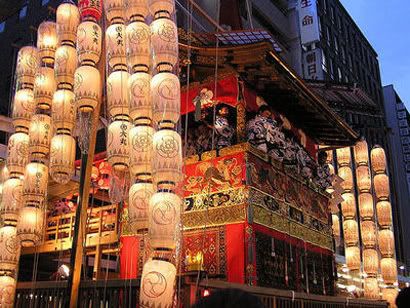
Gion Matsuri is one of the biggest, most famous, and most beautiful festivals in Japan. Although the festival actually lasts the entire month of July, the climax is the Procession of Floats on July 17. For a few nights leading up to Yama Hoko Junko, the people of Gion display their magnificent festival floats and priceless family treasures, handed down from generation to generation for hundreds of years.

As the sun disappears behind the mountains that embrace the city, the soft light of paper lanterns sets the floats a glow. The kon-chiki-chin of Gion bayashi (traditional festival music of Gion) mingles with the sound of traditional flutes dancing on the Kyoto air, thick with the chants of young men pulling mikoshi (portable shrines) and the ringing of the bells that dangle down on each side of the floats. Dressed in yukata, a summer kimono made of cotton, geta, high wooden sandals, and traditional festival regalia, the people that fill the streets only add to the heavy sense that if only for tonight, Kyoto is the same today as it was over a thousand years ago, when this festival began.
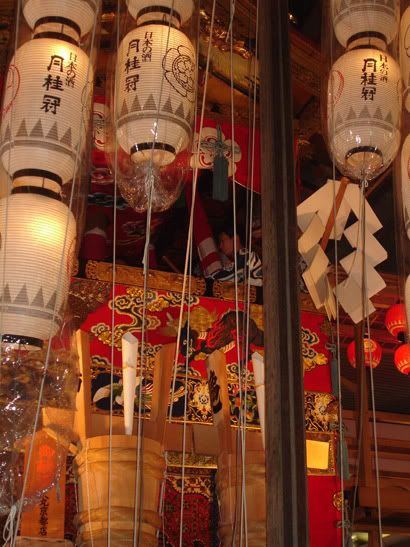
We arrived in Kyoto the night of Yoiyama, the eve of the big procession. Jen, the High school ALT in Ena, had never been up to Kiyomizudera, so I took her on a walking tour of Higashiyama. The narrow roads up to the temple were begining to fill with brightly colored yukatas, and the clip-clop of geta on the stone-paved roads echoed in the alleyways.
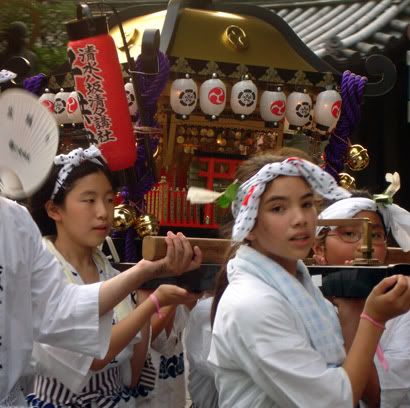
As we headed back towards Shijo, the main avenue, the sound of festival flutes and chants of "Wa-shoi! Wa-Shoi!" filled the air. Near Kodaiji (temple) we came across school of elementary school students, preparing to make their runs with their own Mikoshi (portable shrine).


Festival participants wear happi, traditional festival gear something like a short yukata decorated with the emblem of their group (neighborhood, school, club...).

Maruyama Koen was a romantic refuge from the bustle of the busy streets. Many couples, dressed in yukata, sought shelter beneath the famous cherry trees as they shared snow cones, a summer festival favorite.

Maruyama Koen was a romantic refuge from the bustle of the busy streets. Many couples, dressed in yukata, sought shelter beneath the famous cherry trees as they shared snow cones, a summer festival favorite.
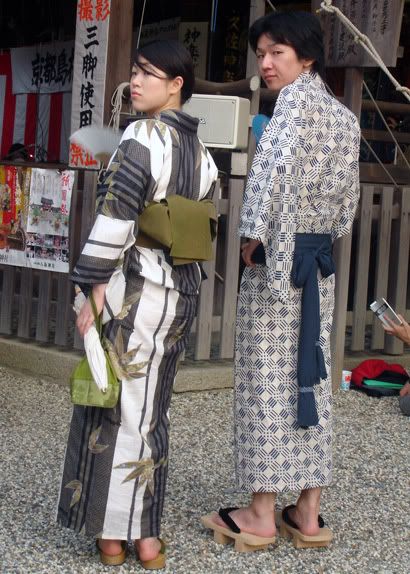
Yasaka Shrine, once known as Gion Shrine and namesake of the festival, was full of stylish spectators seeking a glance of the sacred mikoshi. (The man above is wearing geta, high, wooden sandals.)

The sacred mikoshi, at rest at Yasaka Shrine.

The sacred mikoshi, at rest at Yasaka Shrine.

A flock of exotice birds head for Yasaka shrine.
When we finally made it down to the main Avenue, the streets had already been closed to traffic, and were steadily filling with a constant stream of spectators and participants. As we waked towards Minamiza, I noticed a stage set up near the Starbucks just before the Hanamikoji, the most famous street in Gion. The banners hanging in the background read " Maiko, Geisha, Kyomai." All my kanji study had finally payed off! Check out my next post to see those pictures!
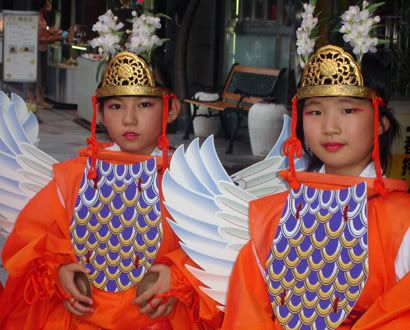
These elementary students preformed a sacred dance in full regalia.
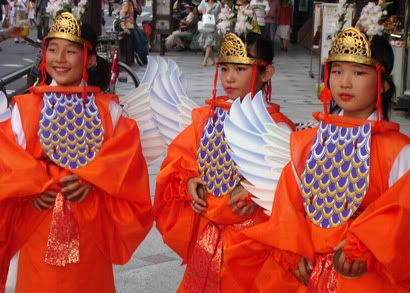

Unfortunately I missed while watching the geiko and maiko dance!
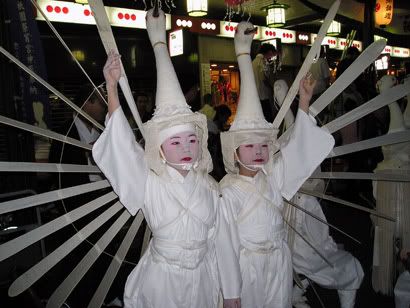

The Swan Dance is another sacred dance performed by young children.
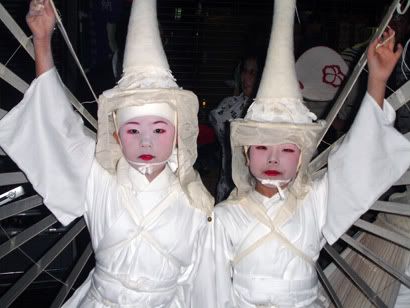






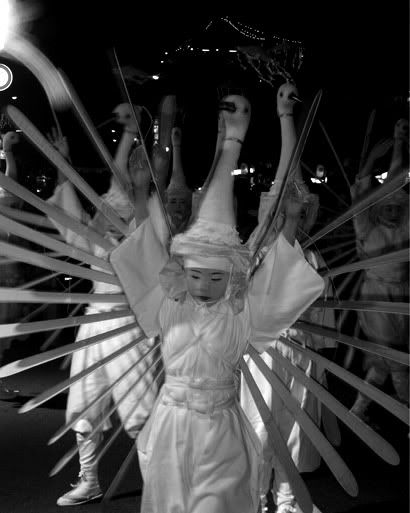








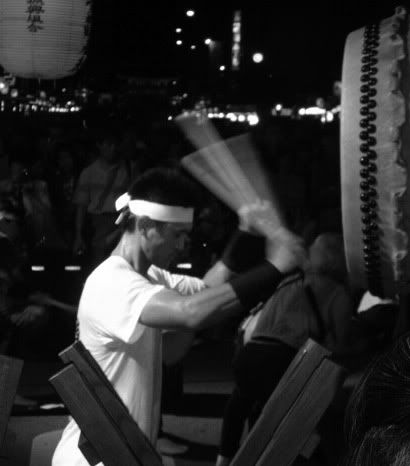
After the swan dance, a taiko group performed. They were awesome! Taiko is the art of playing a Japanese Drum with exaggerated, theatrical movements. Aside from the awesome beat, its really exciting to watch! Lindz and I got really excited and started talking about how awesome this guy was, and a little old obaasan (grandma lady) turned around and shushed us, finger to the lips, librarian style! Those little obaasans have some nerve yo! I'm sure we were almost interupting the performance, consisting of atleast 15 drums, not to mention the thousands of sake-sipping spectators and mikoshi crews chanting on their rounds of the city!
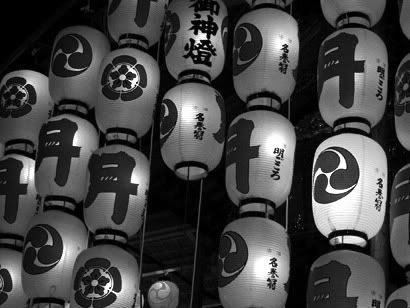
After watching the swan dance, we wandered thru the lantern-lit side streets admiring the floats, family treasures, and festival food. We came across more than a few Maiko, but that's for another post!

Ever since I first came to Japan and heard about Gion Matsuri, it has been at the top of my list of things to do here. As we wandered the streets, casually strolling past maiko, geisha, and their yakuza (Japanese Mafia) patrons, watching young girls in brightly colored kimono chat on perfectly accessorized ketai (cell phones), inhaling the mix of takoyaki (octopus dough balls), yaki soba, and squid on a stick, I can't imagine there is anywhere else I would have rather been. With total disregard for the sacred train timetable, we meandered thru the narrow sidestreets, glowing with the lantern light of the festival floats.

Some how we made the last train back to Shichijo, even though first we got off at the wrong stop and had to hop back on the next train. Before leaving Shijo, which had been magically transformed for the event, the streets reopened and the crowds slowly shifted to the sidewalk. As we tred towards the subway station, a fleet of Japanese deko trucks and pimp mobiles slowly rolled by, bouncing to the beat of Japanese hip-hop. Not exactly the kon-chiki-chin of Gion Bayashi. Once again the juxtoposition of ancient custom and ultra-modern sensitivities left me feeling like the night had been nothing more than a dream.
A dream in which I lost the key to the hostel, still got in the door, but was forced to try to sleep (I failed) in the brightly-lit lounge, the sweat of a day hiking around Kyoto crystalizing on my sun kisssed skin. Luckily I planned to wake up early the next day to get a decent spot on the parade route...


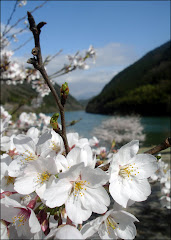

2 comments:
Melissa,
I enjoyed the shots and writeup. Reading it, I felt like I was actually there walking the streets at night. Did the yakuza have their usual fleet of takoyaki stalls out?
Ah yes, the Yakuza were in full effect! I think I got a picture of one with a Maiko!
Post a Comment